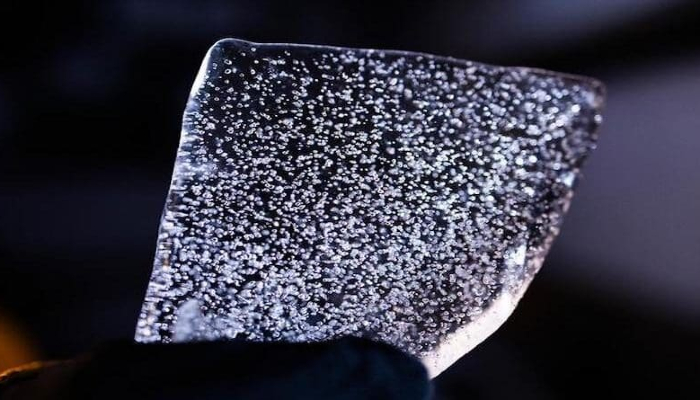Melting glaciers and ice caps are often seen as harbingers of climate change, but within these melting masses lies a treasure trove of information about Earth’s past. One particularly fascinating specimen, a 50,000-year-old block of Antarctic ice, offers unique insights into ancient climatic conditions, atmospheres, and even the evolutionary lineage of certain species. The juxtaposition of such an ancient artifact against contemporary CO2 levels invites us to ponder a compelling question: What stories are locked within these ice-bound time capsules, and how do they challenge our current understanding of Earth’s climatic history?
The Antarctic ice block in question is not merely a block of frozen water; it is a meticulously layered archive of history. Each layer encapsulates information from a specific time period, during which the Earth’s atmosphere experienced a unique composition of greenhouse gases, temperature fluctuations, and even volcanic eruptions. This stratification is akin to the rings of a tree, offering a chronological account of atmospheric conditions through one of the planet’s most critical epochs.
Ice cores, especially those extracted from Antarctic glaciers, are uniquely valuable to researchers. They contain air bubbles trapped within the ice, providing a direct sample of ancient atmospheres. The gaseous contents of these bubbles allow scientists to reconstruct past CO2 levels, temperature variations, and even biogenic activities. The data gathered can yield insights ranging from the Pleistocene epoch’s glacial-interglacial cycles to more recent historical periods that witnessed drastic climate shifts.
The analysis of this ice core reveals that atmospheric CO2 levels have fluctuated dramatically over millennia. These fluctuations correlate not only with natural phenomena, such as the Milankovitch cycles that dictate Earth’s climatic variations but also with anthropogenic influences observed since the Industrial Revolution. The stark contrast between pre-industrial and current CO2 concentrations highlights a significant challenge: How can society reconcile modernity’s demands with a sustainable approach to environmental stewardship?
The ancient ice can illuminate trends that may seem esoteric at first glance, yet they resonate profoundly in today’s climate discourse. For example, during the Last Glacial Maximum, approximately 20,000 years ago, CO2 levels hovered around 180 parts per million (ppm). In stark contrast, current levels are reported to be over 400 ppm. This surge poses a daunting question for climatologists: What precisely triggers these disproportionate increases, and how do they affect future climatological scenarios?
Moreover, this ancient block of ice plays an intriguing role in elucidating past ecosystems. The presence of specific isotopes and chemical signatures informs researchers about changes in flora and fauna over millennia. Ancient pollen and microbial life trapped within the ice provide invaluable clues about how ecosystems adapted to dramatic shifts. These insights directly affect our understanding of current biodiversity and the potential trajectory of extinction, driven largely by rapid climate change. Are we heedlessly accelerating toward an ecological threshold where species resilience is compromised?
The ramifications of studying such an ancient ice core extend beyond mere historical understanding—they influence current policy and conservation strategies. As coastal cities grapple with rising sea levels and changing weather patterns, data extrapolated from ice cores can aid in predictive modeling. These models assist policymakers in navigating the complexities of environmental protection, habitat preservation, and urban planning. Avoiding catastrophic outcomes requires not only acknowledging the lessons from the past but also applying them adeptly to present-day challenges.
However, the narrative is not solely about gloom and doom; it is also about innovation and resilience. The knowledge gleaned from these ice records can catalyze the development of adaptive strategies to combat climate change. Researchers explore avenues such as carbon capture technology, sustainable agricultural practices, and renewable energy solutions, seeking ways to harmonize human existence with the planet’s delicate ecological balance.
Yet, the question remains: can humanity muster the collective willpower to implement these changes on a global scale, and, if so, how? The societal inertia surrounding climate issues presents significant obstacles. This ice block serves as a clarion call for introspection, urging individuals and communities to reassess their roles in this multifaceted challenge. Are we prepared to embrace the responsibilities that echo through the layers of ice?
As the ice continues to melt, it will inevitably yield more samples, each layer presenting wilting secrets from eons past. Future research may elucidate mysteries we have yet to grasp fully, demonstrating both the power of nature and the fragility of our existence within its extensive framework. The intersection of ancient ice and contemporary science offers profound narratives that deserve our attention and action.
In conclusion, the exploration of this 50,000-year-old Antarctic ice block is a testament to Earth’s resilience and vulnerability. It stands as an embodiment of nature’s storied past, ripe with lessons that could steer humanity toward a more sustainable future. The secrets encased within this ancient ice continue to provoke inquisitiveness and challenge us to redefine our relationship with the planet. By engaging with these historical narratives, we must rise to meet the challenges of our time and cultivate a future that respects the delicate balance of our shared world.
